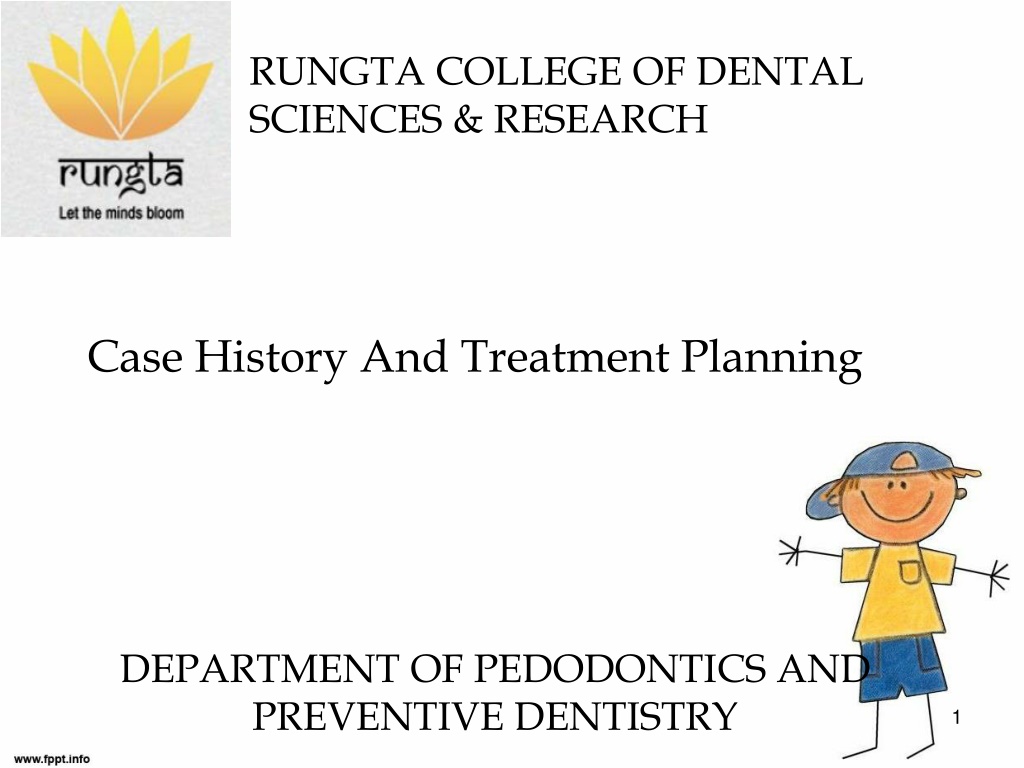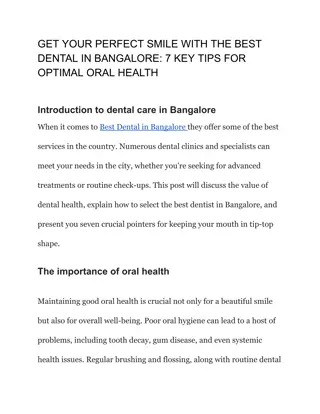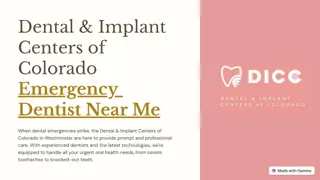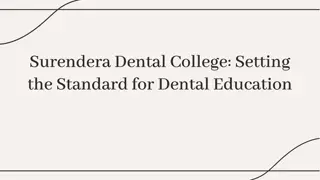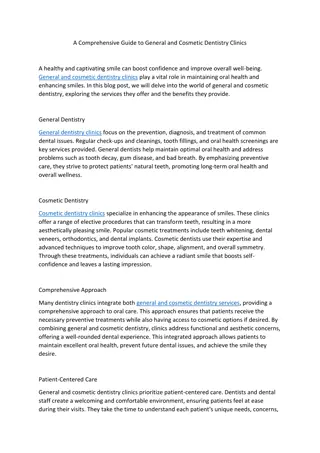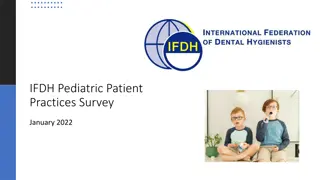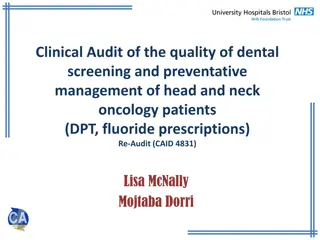Pediatric Dental Case History and Treatment Planning Guide
Detailed guide on recording case history, clinical examination, provisional and final diagnosis, treatment planning, and key terminologies in pediatric dentistry. Emphasizes the importance of thorough evaluation for successful dental care in children.
Download Presentation

Please find below an Image/Link to download the presentation.
The content on the website is provided AS IS for your information and personal use only. It may not be sold, licensed, or shared on other websites without obtaining consent from the author. Download presentation by click this link. If you encounter any issues during the download, it is possible that the publisher has removed the file from their server.
E N D
Presentation Transcript
RUNGTA COLLEGE OF DENTAL SCIENCES & RESEARCH Case History And Treatment Planning DEPARTMENT OF PEDODONTICS AND PREVENTIVE DENTISTRY 1
Specific learning Objectives Core areas Domain Introduction Examination Vital statistics Diagnosis Chief complaint Treatment planning History 2
Category Recording the history Clinical examination MUST TO KNOW Provisional diagnosis Special examination NEED TO KNOW Final diagnosis Treatment planning DESIRE TO KNOW 3
Contents Contents Introduction Vital statistics Chief complaint History Examination Diagnosis Treatment planning References 4
Introduction Introduction Successful dental care for children is best achieved by recording a detailed history,a complete clinical examination, appropriate investigation, a thoughtful diagnosis, and the formulation of a proper treatment plan. 5 Shobha Tandon.Text book of pedodontics.2ndedn,2009.p9-17
Provisional diagnosis: a general diagnosis based on clinical impression without any laboratory investigations. Final diagnosis: a confirmed diagnosis based on all available data. Symptom :any morbid phenomenon or departure from the normal in structure, function or sensation experienced by patient and indicative of a disease. 6 Shobha Tandon.Text book of pedodontics.2ndedn,2009.p9-17
A few terminologies need to be understand before A few terminologies need to be understand before recording case history recording case history : Case history : classic form of documentation which ranges from clinical sketches to highly detailed and extended accounts that help in arriving diagnosis and t/t plan of a person under study. Diagnosis : the process of identifying a disease by careful evaluation of sign and symptoms. Differential diagnosis: the process of listing out two or more diseases, having similar sign and symptoms of which only one can be attributed to the patients suffering. 7 Sydney B. Finn Clinical Pedodontics.4thedn.2004.p71-91 Shobha Tandon.Text book of pedodontics.2ndedn,2009.p9-17
Sign : any abnormality indicative of disease, discovered on examination of the patient. So each component of case evaluation is significant and should be allotted the due importance. Three types of examination appointments are common Emergency Recall Complete 8 Shobha Tandon.Text book of pedodontics.2ndedn,2009.p9-17
Recorded history of a Recorded history of a Pedodontic can be divided into can be divided into - - Vital statistics Chief complaint Medical history Parentral history Prenatal history Natal history Postnatal history Pedodontic patient patient 9
Vital statistics :it can be defined as a systematic approach to collect and compile ,in numerical form, information related to vital events, live births, deaths, recognition, social structure, and legislation. Date records patients first visit which can be referred back to the follow up visits. Hospital registration no. for the purpose of maintaining a record, billing filling and for legal considerations. Name by asking a name is a verbal communication which establishes a rapport with the patient . (Nickname helps in making the environment friendly). 10 S.G Damle.Text book of pediatric dentistry.4thedn. 2012.p 257-265
Age: Chronological age( date of birth) should be noted to compare with other ages (dental, skeletal) To choose behaviour management techniques. To relate the eruption and exfoliation sequence of teeth. To initiate any preventive or interceptive methods of treatment. To determine drug doses. 11 S.G Damle.Text book of pediatric dentistry.4thedn. 2012.p 257-265
GROWTH ASSESMENT PARAMETERS To recognize disparity b/w dental, mental, chronological and skeletal age. To correlate following ages. To aid in t/t planning. Growth modification by means of functional and orthodontic appliances during the growth spurts. Age related disease. 12
School and class: to know the economic status and to assess the IQ of the child and to establish effective communication at his own IQ level. Parents name and occupation : - Understanding the socioeconomic status. Address: - Communication, by knowing the locality, along with the family income ,and parents occupation, socioeconomic status can be assessed. Living area may indicate diseases endemic to that region like water fluoride content. 13 S.G Damle.Text book of pediatric dentistry.4thedn. 2012.p 257-265
Chief complaint recorded in patients or parents own words. Several factors need to be evaluated regarding chief complaint and it must be in chronological order. History of presenting illness evaluated under Onset Duration Location Frequency of occurrence, quantity,quality,severity Aggravating and relieving factors Associated symptoms 14
Medical history history of any medical conditions including recent hospitalizations, blood transfusion etc. Antibiotic prophylaxis must be given prior to minimize the risk of SABE or any drug allergy. Past dental history Patients experience before, during and after dental t/t. H/O complications experienced by the patients. Parental history Indication of hereditary development of patient. Tells what value parents place on their own teeth and it may be reflected in the apprehensiveness of the child. 15 Sydney B. Finn Clinical Pedodontics.4thedn.2004.p71-91
Prenatal and Natal history Provide clues to the origin of abnormal color, shape and structure of deciduous and permanent teeth like tetracyline. Effect of drug and metabolic disturbance which occurred during the formative stages of the teeth. Birth history : suggests if any problem encountered with birth like- premature delivery -trauma due to forcep s delivery -Rh incompatibility -neonatorum jaundice 16 Sydney B. Finn Clinical Pedodontics.4thedn.2004.p71-91
Postnatal and Infancy history Significance attached to the amount of time the child was breast fed, bottle fed, prolong feeding etc. Vaccination status need to be assessed. Presence of any habit its duration, frequency and intensity need to be evaluated. Records information as previous preventive t/t for dental caries. Developmental disturbances of dental significance Allergies, nervous habits. 17
General survey of the patient Examination of Head and Neck Treatment planning Examination outline Examination of the oral cavity Diagnosis Speech, swallowing and perioral musculature 18 Sydney B. Finn Clinical Pedodontics.4thedn.2004.p71-91
Gait how the child walks examiner can quickly ascertain whether the gait is normal or affected. Most common abnormal gait is that of sick child is weak ,unsteady and lethargic type. Types waddling- feets are apart n walk like duck. equinus- horse like walk scissor- walking with cross legs hemiplegic- seen in paralysis steppage- footdrop due to loss of dorsiflexion Shuffling/ wobbly-walking with sliding feet staggering and ataxic.-uncontrolled unsteady gait Such type of gait should be carefully evaluated. 19 Sydney B. Finn Clinical Pedodontics.4thedn.2004.p71-91
Built William Sheldons categorized human bodies in 3 categories: 3 types based on anthropometry and anthroposcopy Ectomorph- late maturer, tall, thin,fragile long and slender extremities with minimum subcutaneous fat. Endomorph early maturer, round shaped, underdeveloped muscles with soft body. Mesomorph- upright and athletic body and hard muscular body. 20 Stephen H. Y. Wel. Pediatric Dentistry total patient care.1988.p101-114
Outline for Outline for Pedodontic Treatment planning Treatment planning Pedodontic Periodic recall examination & maintenance t/t Corrective t/t Preparatory t/t Systemic t/t Medical t/t Referral to the physician Premedication Therapy for oral infection Oral Operative dentistry Prosthetic dentistry Orthodontic therapy Every 4 to 6 months prophylaxis Caries control Orthodontic consultation Oral surgery Endodontic therapy 21 Sydney B. Finn Clinical Pedodontics.4thedn.2004.p71-91
MEDICAL TREATMENT : When history & examination suggest medical problem --- consult physician to ensure health and safety. If a parent is uncertain about a past disease(rheumatic fever),but has answered questions affirmatively, child should be referred to a physician. Blood dyscriasis are reflected in oral cavity by changes in color,size,shape,consistency. So medical specialist can advise the dentist about handling the dental needs of child safety. 22
SYSTEMIC TREATMENT Premedication - in apprehensive child, spastic patient, pt with cardiac problems is necessary. And it should be done only after consultation with child s physician. The exact doses of all drugs to be used should be entered on the treatment plan. Systemic drug therapy may cause oral tissue changes which make restorative t/t difficult for e.g. Dilantin sodium causes hypertrophic gingivae so such condition should be discussed with physician to alleviate the problem and treatment can proceed. 23 Sydney B. Finn Clinical Pedodontics.4thedn.2004.p71-91
PREPARATORY TREATMENT: After medical status and premedication regime of the child establised following phase concerned- Preparatory phase: Behaviuor management-the child s behaviour shaping should start right from the reception itself. Oral prophylaxis- it presents a clearer view of caries process which facilitates its diagnosis. Caries control- further progress of carious lesion should be controlled . Orthodontic consultation- preventive orthodonticprogramme should be planned before any intervention. 24
Surgical phase Extraction of teeth with poor prognosis Surgical exploration of desirable teeth Extraction of undesirable teeth Extraction for orthodontic reasons. Topical fluoride application Fissure sealant application CORRECTIVE TREATMENT Restorative phase Composite restoration Amalgam restoration 25 Stephen H. Y. Wel. Pediatric Dentistry total patient care.1988.p101-114
Pulp therapy procedure Stainless steel crown restoration Orthodontic phase Space management Removable appliance therapy Functional appliance therapy Fixed appliance therapy Extensive esthetic restorative surgical phase Esthetic contouring Esthetic veneering/ bleaching Porcelain jacket crown Removable prosthodontic procedure 26 Stephen H. Y. Wel. Pediatric Dentistry total patient care.1988.p101-114
MAINTENANCE PHASE: Depending upon risk of the individual and his oral hygiene status,a 3-6 month recall visit can be establised for the following- Review of oral health status by repeating indices and comparing with initial indices. Caries activity tests maybe repeated. Reinforcement of home care measures. Motivation and re-counselling of parents if required. Follow-up of treatment procedures. 27 Stephen H. Y. Wel. Pediatric Dentistry total patient care.1988.p101-114
References References Sydney B. Finn Clinical Pedodontics.4th edn.2004. Stephen H. Y. Wel. Pediatric Dentistry total patient care.1988. Pinkham.Pediatric dentistry infancy through adolescence.4thedn. 2012 Shobha Tandon.Text book of pedodontics.2nd edn,2009 28
